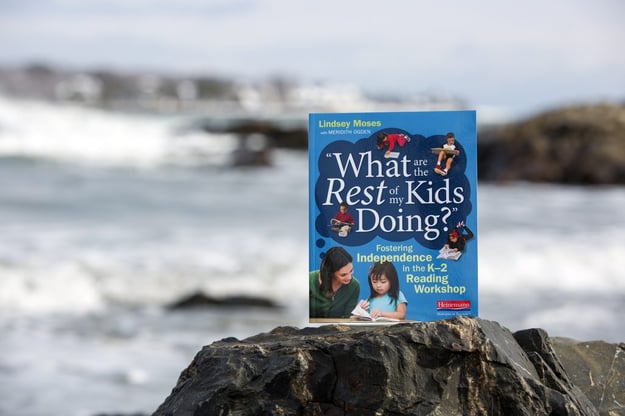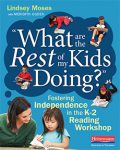
Managing classroom libraries requires a delicate balance between organization, choice, behavior, and matching children with appropriate texts. Classroom libraries can be organized in many ways-- by genre, series, or some other category. Susan Taberski (2000) suggests having bins of unleveled books from which students choose their independent reading selections and bins of books by level for when they need practice with something "just right." Other teachers label their books using the Fountas and Pinnell A through Z gradient.
Because an "assessed" reading level doesn't always correspond with a student's level of comprehension, it is important that students spend time with more than just independent-level texts. To do this, it is necessary to spend time working with students on independent text selection that supports decoding development, fosters comprehension and thinking, and pique students' interests in reading.
"But How?" you might ask...
In their new book But what are the Rest of My Kids Doing: Fostering Independence in the K-2 Reading Workshop Lindsey Moses and Meridith Ogden outline the approach they use to teach the students in their class just how to "book shop". Starting with preassessment, involving the observation of each student's choices, and moving into lessons created to specifically teach the skill of selecting "just right" books, Moses and Ogden move teachers through the entire process including scaffolding, monitoring and helping students to refine their choice-making.
Book shopping became a social and productive time when students engaged with books and one another in the process of finding new, interesting books for the week. --lindsey Moses and Meridith Ogden
The amount of time students spend reading in school is associated with gains in reading achievement (Taylor, Frye, and Maruyama 1990), and this holds true for beginning readers, struggling readers, and students reading in a second language. Independent reading also fosters positive attitudes toward reading, especially in the primary grades (Yoon 2002). Researchers have validated the efficacy of scaffolded and supported independent reading for developing fluency and comprehension in reading (Reis et al. 2008; Reutzel, Fawson, and Smith 2008). Scaffolded silent reading includes instruction in selecting "good fit" books and teachers conferences with four to five students per day.
♦ ♦ ♦ ♦

To learn more about how to support independent reading and book choice in your own classroom instruction, check out "What are the Rest of my Kids Doing?" by Lindsey Moses and Meridith Ogden. To learn more about the book and download a sample chapter, click here.
♦ ♦ ♦ ♦
What are the Rest of My Kids Doing? was recently featured on the Nerdy Book Club website. You can read the full article here.
♦ ♦ ♦ ♦
 Lindsey Moses is an assistant professor of literacy education at Arizona State University. A former elementary teacher, Lindsey works with classroom teachers around the country supporting the implementation of effective literacy instruction in diverse settings. Her research focuses on elementary literacy instruction and English learners. Lindsey is the coauthor of Comprehension and English Language Learners and author of Supporting English Learners in the Reading Workshop, which provides research-based, teacher-tested instruction and differentiation ideas that facilitate success for diverse learners.
Lindsey Moses is an assistant professor of literacy education at Arizona State University. A former elementary teacher, Lindsey works with classroom teachers around the country supporting the implementation of effective literacy instruction in diverse settings. Her research focuses on elementary literacy instruction and English learners. Lindsey is the coauthor of Comprehension and English Language Learners and author of Supporting English Learners in the Reading Workshop, which provides research-based, teacher-tested instruction and differentiation ideas that facilitate success for diverse learners.
 Meridith Ogden has worked as a first and second-grade classroom teacher in the greater Phoenix area for the past twelve years. She is currently working as a first-grade demonstration teacher in the Paradise Valley Unified School District, where she shares her passion for Reading Workshop with other educators.
Meridith Ogden has worked as a first and second-grade classroom teacher in the greater Phoenix area for the past twelve years. She is currently working as a first-grade demonstration teacher in the Paradise Valley Unified School District, where she shares her passion for Reading Workshop with other educators.
References
Reis, Sally M., Rebecca D. Eckert, D. Betsy McCoach, Joan K. Jacobs, and Michael Coyne. 2008. “Using Enrichment Reading Practices to Increase Reading Fluency, Comprehension, and Attitudes.” The Journal of Educational Research 101 (5): 299–314.
Reutzel, D. Ray, Parker C. Fawson, and John A. Smith. 2008. “Reconsidering Silent Sustained Reading: An Exploratory Study of Scaffolded Silent Reading.” The Journal of Educational Research 102 (1): 37–50.
Taberski, Sharon. 2000. On Solid Ground: Strategies for Teaching Reading K–3 . Portsmouth, NH: Heinemann.
Taylor, Barbara M., Barbara J. Frye, and Geoffrey M. Maruyama. 1990. “Time Spent Reading and Reading Growth.” American Education Research Journal 27 (2): 351–62.
Yoon, Jun-Chae. 2002. “Three Decades of Sustained Silent Reading: A Meta-Analytic Review of the Effects of SSR on Attitude Toward Reading.” Reading Improvement 39 (4): 186–95.


